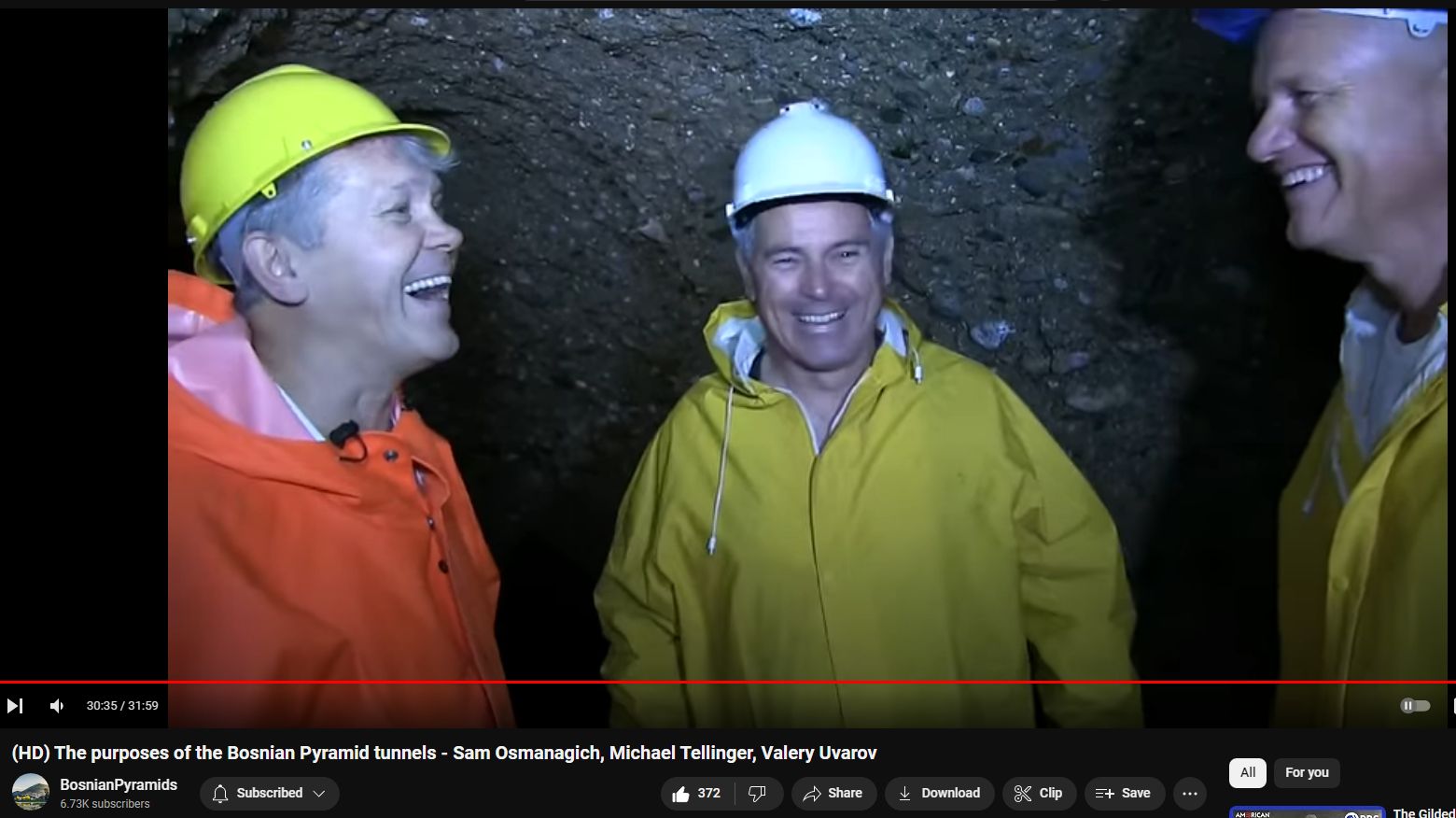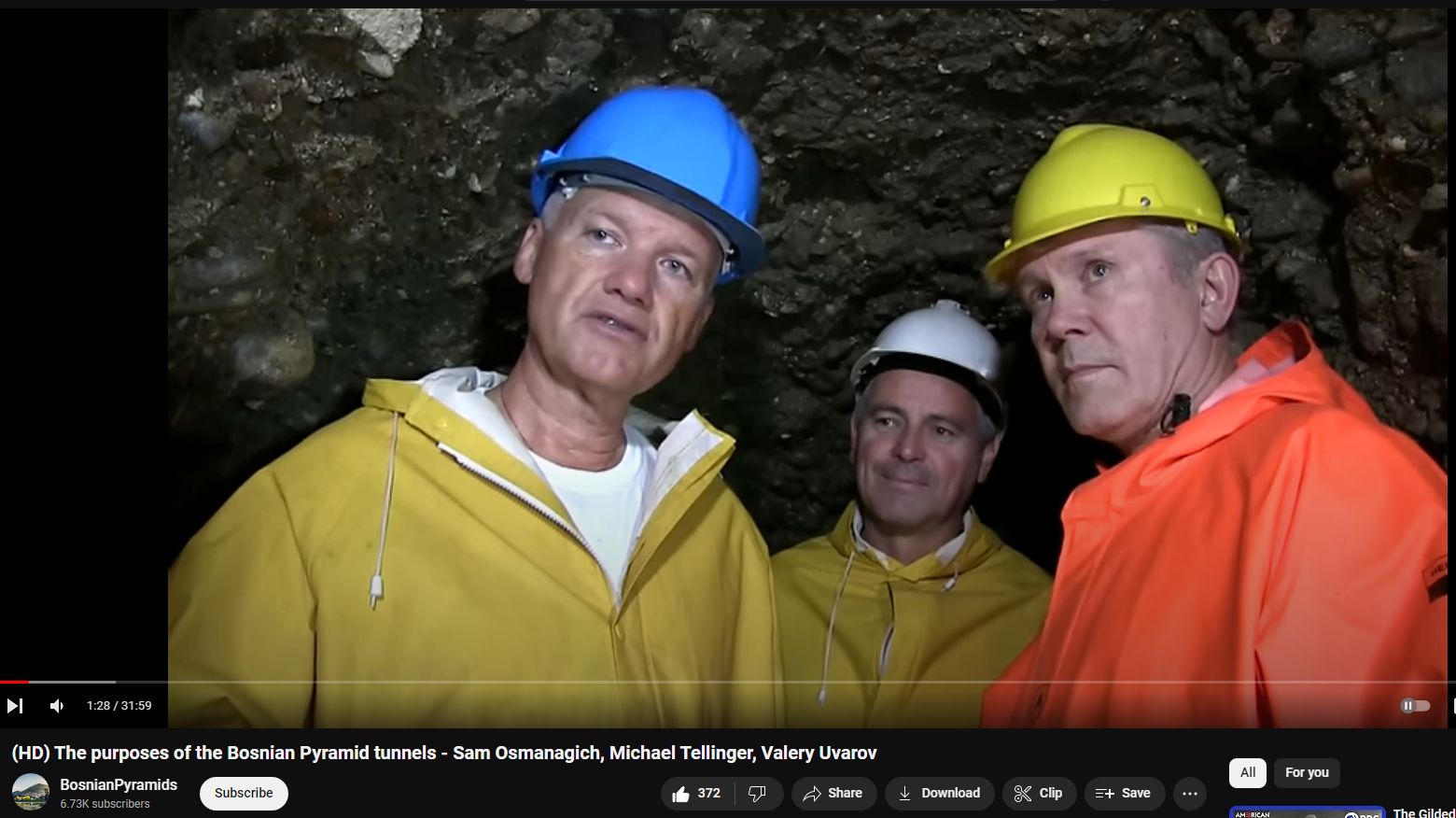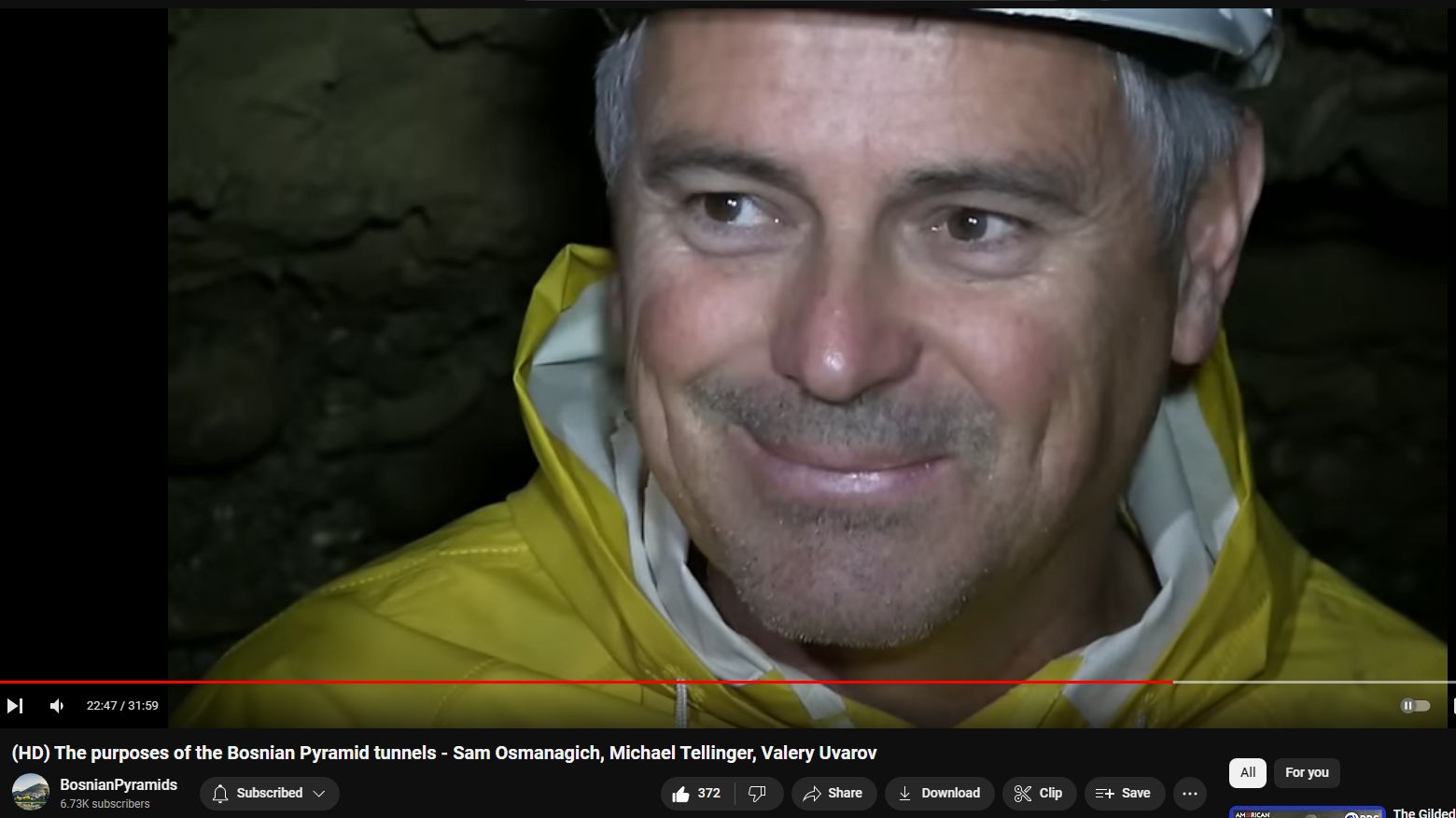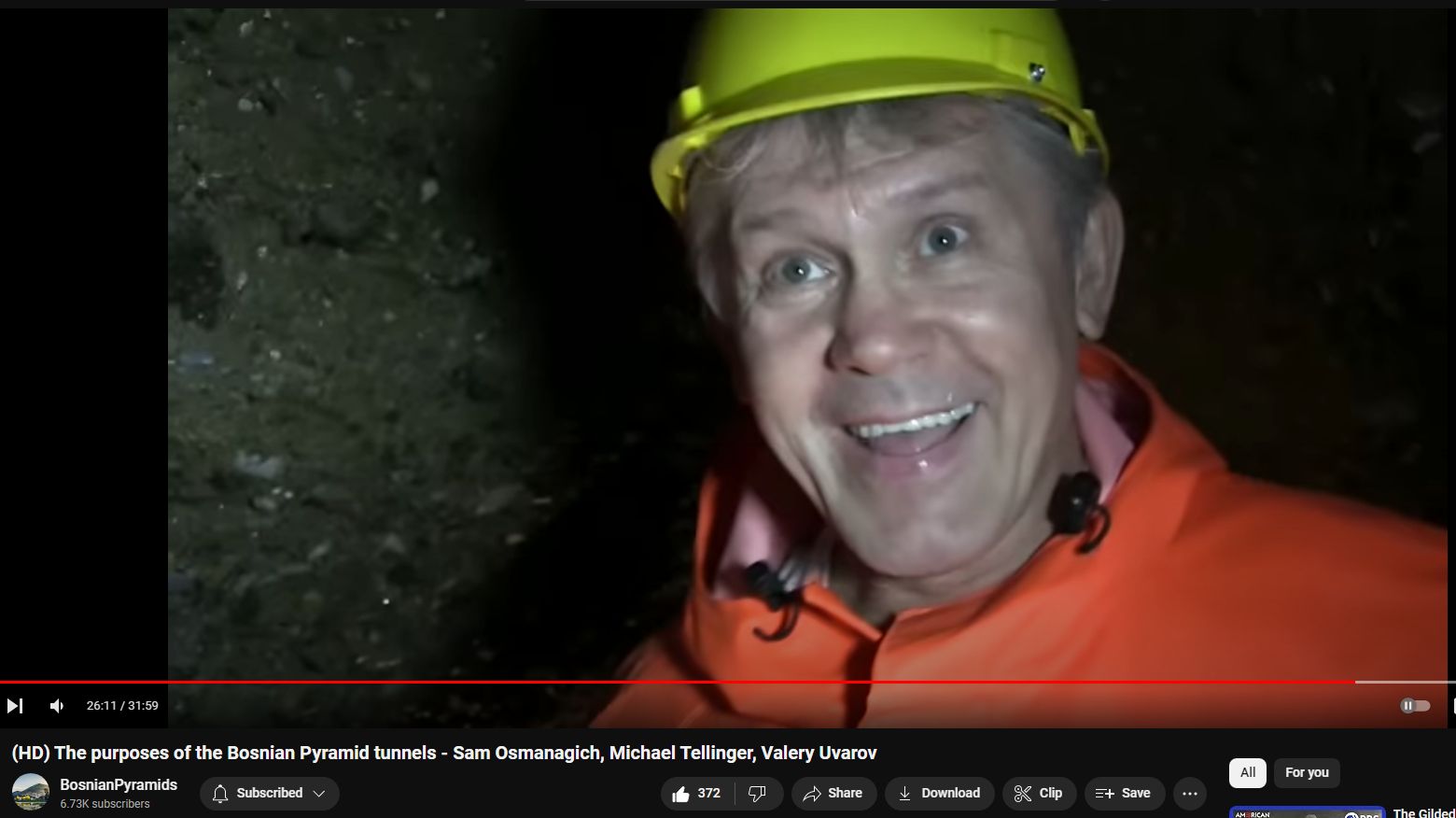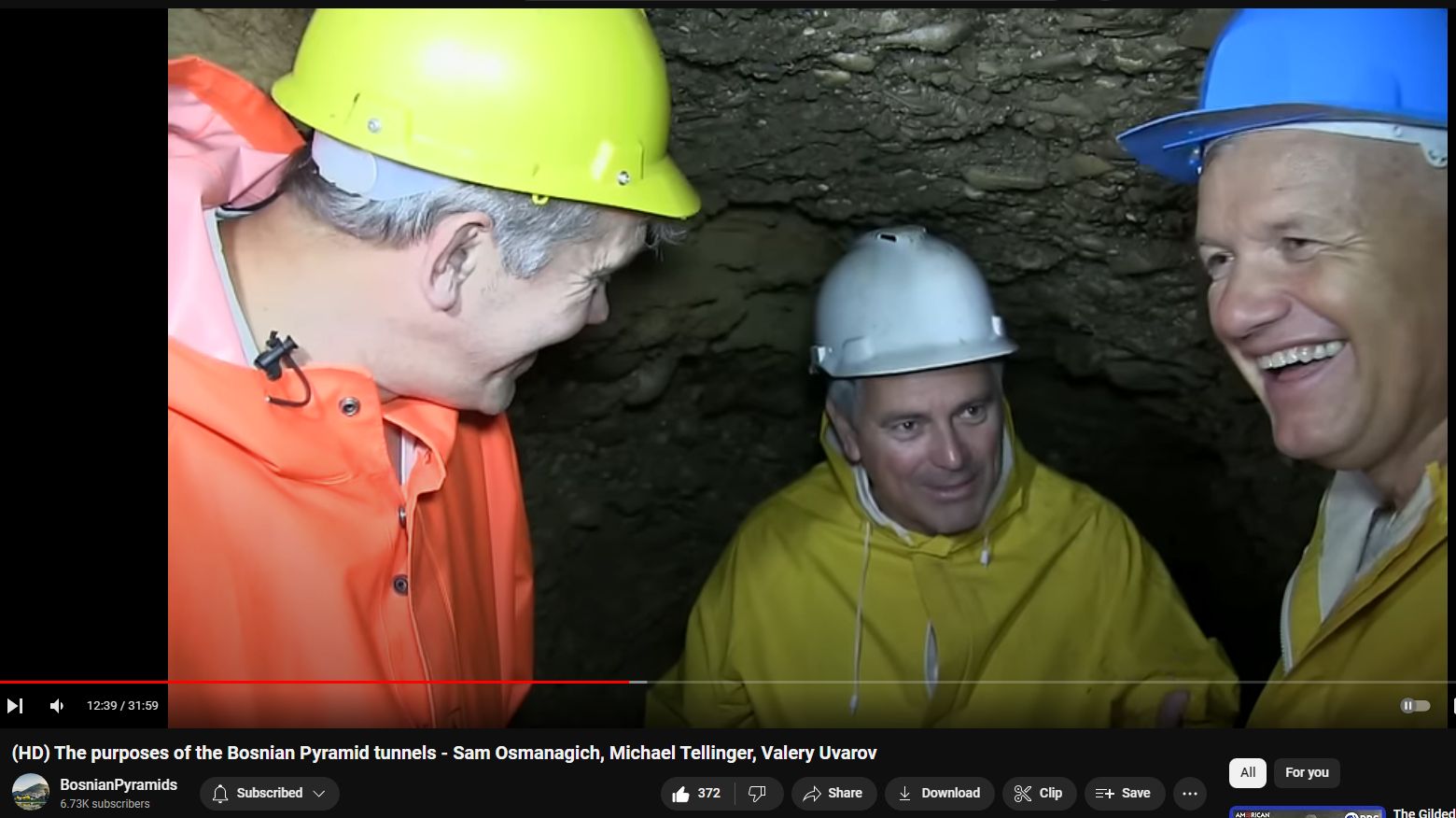Leading world explorers and investigators of ancient technologies, Egyptologist and pyramid builder Valery Uvarov (Russia), discoverer of megalithic circles on African soil Michael Tellinger (South Africa), and Bosnian Pyramids discoverer, academician Dr. Sam Osmanagich (Bosnia/USA) visited newly discovered underground tunnels in the Bosnian Valley of the Pyramids on September 15, 2015.
The Ravne Tunnel Labyrinth network runs for several kilometers beneath the Bosnian Pyramid Complex. The tunnel labyrinth has high concentrations of oxygen and beneficial negative ions, ultrasound (levitation) frequency of 28 kHz, electromagnetism of 28 kHz, and original Schumann resonance of 7.83 Hz.
The best energy fields for physical, mental, and spiritual abilities exist in the tunnels beneath the Bosnian Pyramids.
Official web site: www.bosnianpyramid.org
They relate personal experiences that combine the pinnacle of their many decades of archaeology and research. I N V A L U A B L E.
Valery described an “energetic circulatory system”. Michael described essence from circulation, like lungs. Sam noted the passages, changes in height, and other physical aspects. The complex seems to have been built tens of thousands of years ago; then it was filled in with rubble only a few thousand years ago. Runes found scratched into composite vibratory monoliths leave an eerie message. 60 kilometers of tunnels, only a few have so far been unearthed.
7 levels of spiraling passages, some filled with water. “I becamse energentically bigger” … “tunnel felt smaller on the way out”, sentiment echoed by Tellinger and Uvarov.
https://www.youtube.com/watch?v=27ejEzHaGUA
Michael Tellinger
### Michael Tellinger and the Enigmatic Stone Circles: Exploring Ancient Technologies and the Ubuntu Movement in South Africa
**Introduction to Michael Tellinger**
Michael Tellinger is a figure who sparks curiosity and debate among enthusiasts of ancient civilizations and alternative archaeology. As a South African author, explorer, and proponent of the Ubuntu Movement, Tellinger’s work challenges conventional historical narratives and proposes intriguing theories about ancient technologies that once thrived in South Africa.
**The Ubuntu Movement**
The Ubuntu Movement, closely associated with Michael Tellinger, draws its name from the African philosophy that emphasizes community support, sharing, and the interconnectedness of all individuals. Tellinger has adapted this concept towards a vision of a moneyless society where community contributions drive economic and social activities, aiming to create self-sufficient communities free from the constraints of modern capitalism.
**Mysteries of the Stone Circles**
One of the most captivating aspects of Tellinger’s research is his study of the numerous stone circles that dot the landscape of Mpumalanga, South Africa. Contrary to mainstream archaeological views that these were remnants of traditional dwellings or livestock enclosures, Tellinger proposes a far more spectacular theory. He suggests these stone circles are components of a vast and sophisticated network of energy production sites, utilizing natural sound frequencies and microwaves.
**Technological Hypotheses and Controversies**
According to Tellinger, these stone circles were not merely homes or defensive structures, but part of an ancient system that harnessed the Earth’s energy field. He claims that these structures could generate, amplify, and transmit energy across large distances, supporting what he theorizes was an advanced civilization capable of using natural forces. This hypothesis links closely with his theories about ancient advanced technologies, including the use of microwaves for energy or communication. However, these views are often met with skepticism from the scientific community, which calls for more empirical evidence and peer-reviewed research to substantiate such claims.
**Impact and Modern Relevance**
Despite the controversies, Tellinger’s theories have garnered significant attention, influencing alternative views on archaeology and history. His work has not only stimulated tourism to these ancient sites but also sparked a broader dialogue about the possibilities of ancient technologies and their implications for understanding human history.
**Conclusion: A Call for Open Minds and Continued Exploration**
Michael Tellinger’s contributions go beyond mere speculation; they invite us to question the established views of our past and consider greater possibilities. Whether one agrees with his hypotheses or not, his advocacy for the Ubuntu Movement and his exploration of South Africa’s stone circles encourage a deeper appreciation for the mysteries that our ancient landscapes hold. As we continue to explore these enigmas, perhaps we will uncover more about our ancestors’ capabilities and the true extent of human ingenuity.
This narrative aims not just to inform but to inspire a reevaluation of history and technology, framed within the potent cultural concept of Ubuntu, which might hold the key to reshaping our modern world.
Valery Uvarov
### Valery Uvarov: Unveiling the Secrets of Pyramid Construction and Aetheric Energies
**Introduction to Valery Uvarov**
Valery Uvarov is a name synonymous with the mysteries of pyramid construction and the study of ancient technologies. As a Russian researcher and writer, Uvarov has spent decades delving into the mechanics of pyramids and their profound effects on nature and human consciousness, proposing theories that intersect ancient wisdom with modern scientific inquiry.
**Understanding Pyramid Mechanics**
Uvarov’s research into pyramid mechanics is not merely an archaeological interest but a deep scientific endeavor. He posits that pyramids are not just monumental tombs or temples but sophisticated energy machines that harness and manipulate the Earth’s natural forces. According to Uvarov, these structures are designed to tap into cosmic and terrestrial energy fields, transforming these energies in ways that can stimulate both ecological and human systems.
**The Concept of Aetheric Effects**
Central to Uvarov’s theories is the concept of the aether—a classical element considered by ancient philosophies to be the ‘fifth element’ or quintessence that fills the universe. Uvarov reintroduces this forgotten element as crucial in understanding how pyramids operate. He suggests that pyramids, through their geometry and orientation, can manipulate aetheric energies to produce various physiological and psychological effects. These effects range from enhancing the growth and vitality of organisms to influencing weather patterns and geological processes.
**Pyramids and Nature**
One of the most compelling aspects of Uvarov’s work is his focus on the interaction between pyramids and nature. He has extensively explored how these ancient structures could energize seeds, leading to increased plant growth, yield, and resilience. His experiments suggest that pyramids can create an energy field that alters the molecular structure of seeds and water, enhancing their natural properties and vitality.
**Seed Energization and Agricultural Implications**
The potential agricultural benefits of pyramid energy are immense. Uvarov’s research into seed energization through pyramid exposure has shown promising results, suggesting that such ancient technologies could be harnessed to improve food production and sustainability in modern times. This aspect of his work not only highlights a practical application of pyramid energy but also points to a new paradigm in ecological management and sustainable farming.
**Conclusion: Revisiting Ancient Wisdom for Modern Challenges**
Valery Uvarov’s investigations into pyramid construction and aetheric effects invite us to revisit ancient wisdom through the lens of contemporary science. His work encourages a broader understanding of how ancient structures like pyramids might be more than just historical artifacts—they could be key to unlocking new methods of enhancing life and environment. Whether one views his theories with a critical eye or open curiosity, Uvarov’s contributions undeniably enrich the dialogue about our historical heritage and its implications for present and future generations.
This exploration of ancient technologies and their applications today challenges us to think beyond conventional boundaries and consider how merging old knowledge with new technologies could revolutionize our approach to global challenges.
Dr Samir Osmanagich
### Dr. Sam Osmanagich and the Bosnian Pyramids: Unraveling Ancient Secrets Through Modern Research
**Introduction to Dr. Sam Osmanagich**
Dr. Sam Osmanagich has emerged as a pivotal figure in the world of alternative archaeology, particularly known for his work on the Bosnian Pyramids and Ravne Tunnels. As a Bosnian-born American anthropologist, he has dedicated much of his career to exploring these sites, which he believes could redefine our understanding of ancient civilizations.
**The Bosnian Pyramids**
Dr. Osmanagich’s most notable claim to fame is his discovery and ongoing research into what he asserts are the largest and oldest pyramids in the world located in Visoko, Bosnia. These structures, including the Pyramid of the Sun, the Pyramid of the Moon, and the Pyramid of the Dragon, are proposed by Osmanagich to be man-made and significantly older than the Egyptian pyramids. His hypotheses suggest that these pyramids were built using geometric precision to harness natural energies.
**Understanding Pyramid Mechanics**
Central to Dr. Osmanagich’s research is the belief that the Bosnian Pyramids were constructed with a deep understanding of geometric principles, orientation, the use of natural materials, and their interaction with Earth’s energy fields. He argues that these pyramids might have served as energy machines that harnessed or amplified natural resonances, potentially for purposes of healing, enhancing well-being, and communication.
**Ravne Tunnels: Unveiling Hidden Networks**
Alongside the pyramids, the Ravne Tunnels have been a significant focus of Dr. Osmanagich’s research. These underground tunnels, running several kilometers, are believed by Osmanagich to predate the pyramids and to have served as conduits for energy. His explorations suggest that these tunnels were part of a larger network designed to channel and enhance natural energies that were interconnected with the pyramids.
**Aetheric Effects and Implications for Science and Nature**
Dr. Osmanagich also delves into the implications of these structures on natural and human systems. He discusses the potential of pyramid energy to influence both ecological systems and human health, proposing that the aetheric effects generated by the pyramids’ design could lead to practical applications in energy medicine and agricultural productivity.
**Global Interest and Archaeological Debate**
The work of Dr. Osmanagich has not only attracted global attention but also sparked significant debate among the archaeological community. While mainstream scientists often question the validity of his claims due to a lack of conventional archaeological evidence, his research has nonetheless inspired a following that is keen on exploring alternative histories and the mysteries of ancient technologies.
**Conclusion: Bridging Past and Future Through Exploration**
Dr. Sam Osmanagich’s persistent exploration of the Bosnian Pyramids and Ravne Tunnels challenges us to consider broader possibilities in the history of human civilization. Whether one views his theories as revolutionary or controversial, his work undeniably encourages a deeper inquiry into ancient technologies and their potential modern-day implications. As research continues, these ancient structures may yet reveal secrets that could not only rewrite history but also offer insights into sustainable technologies derived from ancient wisdom.
This exploration is a testament to the enduring human quest for knowledge and understanding, pushing the boundaries of traditional archaeology to integrate science, history, and mystery in the search for truth.
